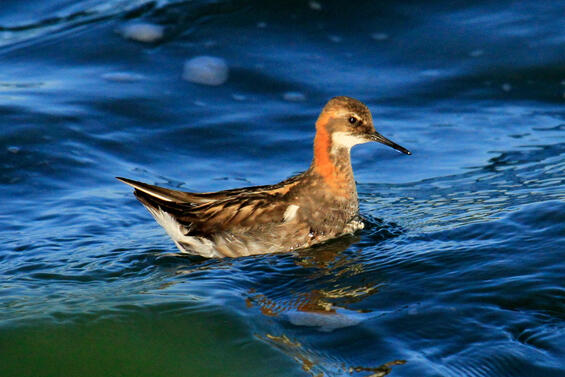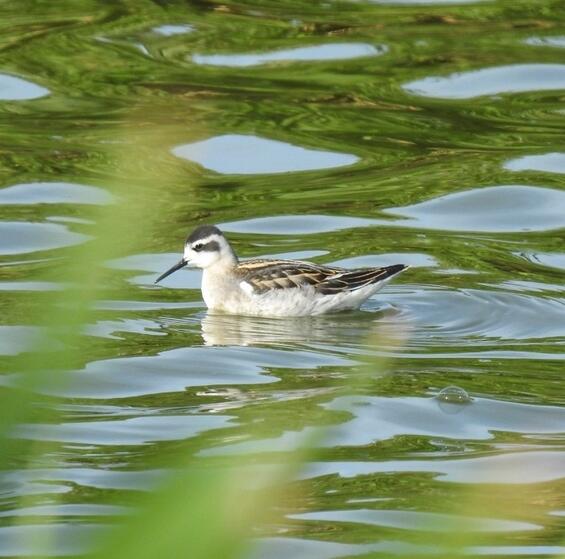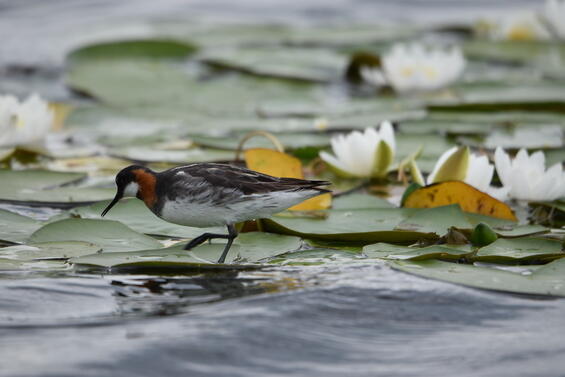- Scientific name: Phalaropus lobatus
- Species of Greatest Conservation Need (MA State Wildlife Action Plan)
Description

The red-necked phalarope is an Arctic breeding shorebird that spends time in pelagic environments during the non-breeding period. They are the smallest phalarope, at only 18-20 cm (7-8 in) long, weighing 20-48 g (0.7-1.7 oz), and with a 32-41 cm (12.6-16.1 in) wingspan. Like all phalaropes, red-necked phalaropes show reversed sexual dimorphism, as females are the more brightly colorful and typically larger sex. While in breeding plumage, adults are dark gray on their heads, neck, breast and backs, with a sharp white chin and eye spot and a bright chestnut that sweeps behind their ear and down the sides of their neck. Both non-breeding individuals and juveniles are white below, with a white head, black eye streaks, and dark patches on the brown and nape. Adults and immatures, however, have gray backs while juveniles are gray with buffy stripes along the back.
Life cycle and behavior

Red-necked phalaropes are migratory shorebirds, spending their breeding period in low Arctic and Subarctic tundra communities and their non-breeding period at-sea typically in tropical waters. They typically begin their northbound migration beginning in mid-April and arrive at their breeding grounds starting in late May. Males are responsible for incubating eggs and feeding young, and the female typically departs the nest after the last egg is laid. Red-necked phalaropes typically have one brood per season. However, polyandry occurs occasionally, and females may produce two broods within a single breeding season. Clutch sizes are normally four eggs. The male incubates the nest between 17-29 days. Chicks are highly precocial and completely downy at hatch. Chicks feed themselves, with the male typically leading chicks to foraging areas. Brooding decreases after 10-14 days and chicks are capable of flight by 16-17 days old.
Southbound migration is staggered. Females depart the breeding grounds first from mid-June to mid-July, followed by males and then juveniles. Arrival at the breeding grounds ranges from late August into October, with some small numbers arriving as late as November. Migration occurs both offshore and overland.
Age at first breeding can be as young as one year old. The oldest known individual was at least five years old, but it likely that life span is over 10 years.
Red-necked phalaropes diets are varied and comprise mostly of small aquatic invertebrates. On the breeding grounds, they consume Diptera adults, larvae, and eggs, beetles and spiders. In pelagic environments, main diet items are copepods, euphausiids, insects, marine invertebrates, fish eggs, and seeds. Phalaropes forage using a variety of behaviors, but the most well-known method is spinning. Phalaropes will spin rapidly, which creates their own localized upwelling that drives preys towards the surface.
Population status
Available global population estimates are 3,600,000–4,500,000 mature individuals, but data quality for this metric is poor. There are few density estimates available, but large flocks of up to 30,000 individuals have been recorded at staging sites. Estimated population trends are conflicting and require further research. Some report worldwide declines, but it is possible that the global population is stable with some localized population declines.
Distribution and abundance
Red-necked phalaropes are a widely distributed, circumpolar breeder. In winter, they are found offshore of western Central America and northwestern South America, the Arabian Sea, and the East Indies. They are found in pelagic areas in Massachusetts throughout much of the year. Small pockets on individuals have been recorded off southern California, in the Gulf of Mexico, and off southern Argentina.
Habitat

Breeding habitat is low Arctic and Subarctic tundra and tundra-transition vegetation near freshwater lakes, pools, bogs, marshes, and streams. During migration, red-necked phalaropes use open-water habitats. They are mostly marine, either pelagic or near coasts. However, they can also be found in a variety of inland wetland habitats, such as estuaries, salt marshes, bays, and freshwater and salt lakes. They are also found in anthropogenic aquatic infrastructures (e.g. sewage and evaporation ponds). At sea, they are often found near shelf breaks, fronts, and upwellings. Winter habitat is mostly marine. Again, they are found near oceanographic features that bring prey to surface waters.
Healthy habitats are vital for supporting native wildlife and plants. Explore habitats and learn about conservation and restoration in Massachusetts.
Threats
Information on threats to red-necked phalaropes are limited. El Niño Southern Oscillation (ENSO) events may be a significant threat to populations, but the link between ENSO events and severe population declines (i.e. absence of 3 million individuals from a former staging area) is only suspected as of now. Development and degradation of breeding habitat negatively impacts other Arctic-nesting shorebirds, but it is unclear how red-necked phalaropes respond.
Plastic trash in the environment poses a threat as it can be mistaken as food by seabirds and shorebirds and ingested or cause entanglement. Ingested plastics, common for seabirds, can block digestive tracts, cause internal injuries, disrupt the endocrine system, and lead to death. Entanglement from fishing gear and other string-like plastics can cause mortality by strangulation and impairing movements.
Conservation
Management and monitoring are limited. The International Waterbird Census conducts annual monitoring in limited areas of the species’ European range. Key European habitats are identified and should receive protection from alteration and disturbance. MassWildlife’s Natural Heritage and Endangered Species Program does not monitor red-necked phalarope occurrence.
Much research is needed into all aspects of the red-necked phalarope. Research into at-sea biology, identifying and quantifying threats, annual survival, and behavior are all needed on a global scale. Avoid or recycle single-use plastics and promote and participate in beach cleanup efforts.
References
BirdLife International. “Species factsheet: red-necked phalarope phalaropus lobatus.” Birdlife International. 2018. https://datazone.birdlife.org/species/factsheet/red-necked-phalarope-phalaropus-lobatus
Enticott, J., and D. Tipling. Seabirds of the World. Mechanicsburg, PA: Stackpole Books, 1997.
Paleczny, M., E. Hammill, V. Karpouzi, and D. Pauly. “Population Trend of the World's Monitored Seabirds, 1950-2010.” PLoS ONE 10, no. 6 (2015).
Rubega, M. A., D. Schamel, and D. M. Tracy. “red-necked phalarope (phalaropus lobatus), version 1.0.” In Birds of the World (S. M. Billerman, Editor). Cornell Lab of Ornithology, Ithaca, NY, USA, 2020. https://doi-org.silk.library.umass.edu/10.2173/bow.renpha.01
van Bemmelen RSA, Y. Kolbeinsson, R. Ramos, O. Gilg, J.A. Alves, M. Smith M, H. Schekkerman, A. Lehikoinen, I.K. Petersen, B. Þórisson, A.A. Sokolov, K. Välimäki, T. van der Meer, J.D. Okill, M. Bolton, B. Moe, S.A. Hanssen, L. Bollache, A. Petersen, S. Thorstensen, J. González-Solís, R.H.G. Klaassen, and I. Tulp. “A Migratory Divide Among red-Necked phalaropes in the Western Palearctic Reveals Contrasting Migration and Wintering Movement Strategies.” Frontiers in Ecology and Evolution 7:86. 2019. doi: 10.3389/fevo.2019.00086
Veit, R., and W.R. Petersen. Birds of Massachusetts. Lincoln, MA: Massachusetts Audubon Society, 1993.
Contact
| Date published: | May 16, 2025 |
|---|